高一英语语法知识点归纳五篇
高一英语必修一语法知识总结

高一英语必修一语法知识总结不要觉得英语很难,它不难,只要认真去学,肯定能学好。
今天小编在这给大家整理了高一英语必修一语法知识总结,接下来随着小编一起来看看吧!高一英语必修一语法知识总结一般现在时、现在进行时、-ing形容词和-ed形容词的用法考点1:一般现在时的用法1.表示经常性、习惯性的动作。
句中常出现often, usually, sometimes, always, every day等状语。
He goes to school at seven o'clock every day. 他每天七点去上学。
She always takes a walk in the evening. 她常在晚间散步。
We always care about and help each other. 我们总是互相关心、互相帮助。
2.表示普遍的真理、科学事实,也用在格言中。
Light travels faster than sound. 光比声音传播得快。
Actions speak louder than words. 行动比言语更为响亮。
3.在时间状语从句和条件状语从句中,通常用一般现在时代替一般将来时。
When I graduate, I'll go back to the countryside. 我毕业后将回农村。
They won't come to see us if it rains next Sunday. 如果下周日下雨,他们就不会来看我们了。
4.表示按规定或时刻表将要发生的动作,仅限于少数动词,如begin, leave, go, arrive, start等。
The meeting begins at eight. 会议八点开始。
The train starts at nine in the morning. 火车早上九点出发。
5.表示主语的特征、性格或说话时的感觉、状态。
高一英语语法总结分享五篇

高一英语语法总结共享五篇进入中学后,很多新生有这样的心理落差,比自己成果优秀的大有人在,很少有人留意到自己的存在,心理因此失衡,这是正常心理,但是应尽快进入学习状态。
下面就是我给大家带来的高一英语语法总结,盼望能帮助到大家!高一英语语法总结1一般过去时1. 表示过去某一时间发生的动作或存在的状态。
[例句] She went to the zoo yesterday.2. 在时间、条件状语从句中代替过去将来时。
[例句] He said when she came he would tell her.此时此刻完成时1. 表示过去发生或已经完成的某一动作对此时此刻造成的影响或结果。
[例句] —Have you had your supper yet? —Yes, I have just had it.2. 常与介词for, during, in, within, over等引导的时间状语连用, 表示过去的某一行为始终持续到此时此刻。
[例句] I haven’t seen my English teacher for a long time.3. 表示反复或习惯性的动作, 常与several times, once, twice, frequently等频度副词连用。
[例句] I have been to the USA several times.4. 表示从过去到此时此刻没有发生过的动作。
[例句] I haven’t swept the floor for a week.5. 用在时间、条件状语从句中, 表示从句动作先于主句动作完成。
[例句] I’ll tell him after you have left.6. 在“级+ 名词”或在“这是第几次…”之后跟定语从句,从句用此时此刻完成时。
[例句] ①This is the third time I have been there.②This is the best tea I have ever drunk.高一英语语法总结2虚拟条件句的倒装虚拟条件句的从句局部假如含有were, should, 或had, 可将if省略,再把were, should或had 移到从句句首,实行倒装。
人教版高中英语语法归纳总结

人教版高中英语语法归纳总结一、引言本篇文章旨在为高中生提供一份全面而简洁的人教版高中英语语法归纳总结。
通过此总结,学生们可以更好地理解和掌握高中阶段所学的各种语法知识点,为以后的英语学习打下坚实的基础。
二、语法知识点归纳1. 名词* 名词的数(单数/复数)* 名词的性(阳性/阴性)* 名词的所有格* 名词的用法(可数/不可数)2. 动词* 动词的时态(现在/过去/将来时)* 动词的语态(主动/被动)* 动词的语气(一般/进行/完成)* 动词的常用短语和搭配3. 形容词和副词* 形容词和副词的级(原级/比较级/最高级)* 形容词和副词的用法(修饰名词/修饰动词)* 常用形容词和副词的比较级和最高级规则及不规则变化4. 代词和数词* 人称代词、物主代词、反身代词的用法* 疑问代词和关系代词的用法* 数词的用法(表示数量/时间/顺序)5. 介词和连词* 常用介词的用法(表示地点/方向/方式/比较)* 连词的用法(并列/承接/转折)6. 句子结构* 主语、谓语、宾语、表语、定语、状语的用法* 简单句、并列句、复合句的用法* 句子成分的省略和替代的规则三、重点语法规则总结1. 数的一致性:在句子中,名词的数需要与谓语保持一致,以确保句子的清晰和正确。
需要特别注意可数名词的单复数形式和动词数的变化。
2. 时态和语态的正确使用:在描述过去事件,表达持续状态或说明将来动作时,我们需要选择正确的时态和语态。
同时,注意一些特殊的语法结构,如进行时表达已完成的动作。
3. 形容词和副词的比较级和最高级:掌握比较级的用法和规则,了解如何使用than,as…as结构以及如何表达最高级别的比较。
4. 代词和数词的使用:正确使用代词,避免混淆主语和宾语;正确使用数词,表示数量、时间或顺序。
特别注意反身代词的正确使用。
5. 介词的使用:介词是表达空间、时间、比较等概念的关键词。
需要熟悉常用介词的用法,了解介词与名词、形容词等的搭配。
人教版高一英语必修一知识点总结五篇
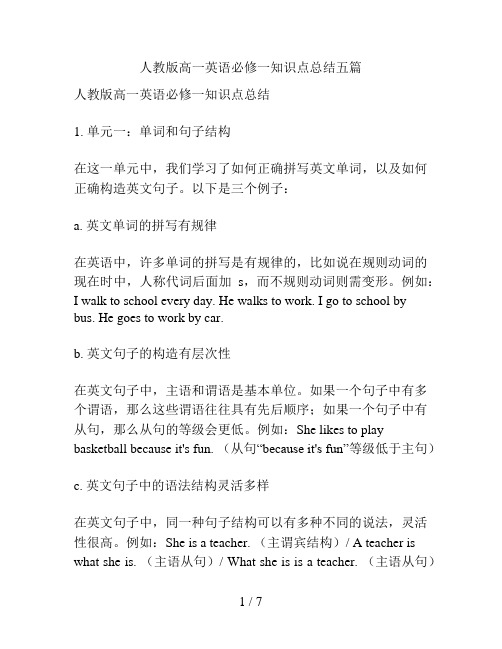
人教版高一英语必修一知识点总结五篇人教版高一英语必修一知识点总结1. 单元一:单词和句子结构在这一单元中,我们学习了如何正确拼写英文单词,以及如何正确构造英文句子。
以下是三个例子:a. 英文单词的拼写有规律在英语中,许多单词的拼写是有规律的,比如说在规则动词的现在时中,人称代词后面加s,而不规则动词则需变形。
例如:I walk to school every day. He walks to work. I go to school by bus. He goes to work by car.b. 英文句子的构造有层次性在英文句子中,主语和谓语是基本单位。
如果一个句子中有多个谓语,那么这些谓语往往具有先后顺序;如果一个句子中有从句,那么从句的等级会更低。
例如:She likes to play basketball because it's fun. (从句“because it's fun”等级低于主句)c. 英文句子中的语法结构灵活多样在英文句子中,同一种句子结构可以有多种不同的说法,灵活性很高。
例如:She is a teacher. (主谓宾结构)/ A teacher is what she is. (主语从句)/ What she is is a teacher. (主语从句)2. 单元二:课文阅读在这一单元中,我们学习了如何正确理解英文课文的内容,并提高了对英文阅读的兴趣和能力。
以下是三个例子:a. 英文课文中的语言运用丰富多样英文课文中的语言运用很丰富,包括比喻、暗示、转喻等等,需要我们认真阅读并理解。
例如:The sky was a bright shade of blue. (比喻)/ Her words cut him like a knife. (转喻)b. 英文课文中的句式多种多样英文课文中的句式也很多样,有短句和长句、简单句和复合句等等。
我们需要慢慢地理解它们,并掌握如何从中获取信息。
英语语法知识点整理优秀5篇

英语语法知识点整理优秀5篇英语语法五大基本句型篇一一、句型1——主语+谓语我们知道,一个句子是为了说明一件事(或表达一种感情),最简单的表达方式,就是“谁,怎么样了”。
这里的“谁”,就是句子的主语,它的内涵很丰富,可以是人、物、某种行为等。
“怎么样了”,就是句子的谓语,由动词充当。
主语+谓语,即构成一个最简单的句子。
举一些简单的例子:I dance.She died.we agree.……二、句型2——主语+谓语+宾语句型2在句型1的基础上多了一个宾语,宾语是什么呢?还是从句子表达事情的角度看,可以理解为“谁,对谁怎么样了”。
宾语,就是主语借助一个动作(谓语)作用的一个对象。
还是举一些简单的例子:I hate him.I love you.I dance with her.(注意,为什么这里多了一个with,学过动词那一节的同学肯定知道哦~)……三、句型3——主语+谓语+间接宾语+直接宾语在这个句型里,我们发现谓语后面跟了两个宾语,直接宾语,就是谓语动词直接作用的对象,而间接宾语,是指谓语需要先借助于一个间接的对象,再把动作传递到直接宾语身上。
如,I give him a book.(“给”,这个动作,最终作用的。
对象是“书”,但需要先通过“他”,把“给”这个动作传递到书)注意,如果理解不了这种句型,关系并不大,只有很少一些动词需要通过接两个宾语的方式来表达完整的意思,记住这些动词就行了。
四、句型4——主语+谓语+宾语+宾语补足语相对于句型2,这种句型中又多了一个宾语补足语,“补足”意思就是补充说明,所以宾语补足语的作用,就是用来补充说明宾语怎么样了。
I want you to go with me.(我要你,要你干什么呢?to go with me,即要你跟我一些走,这个部分就是宾语补足语。
)注意,在这种句型中,补足语可能不是一个具体的单词。
五、句型5——主语+系动词+表语还记得系动词吗?我们在动词那一节也讲过哦,这里就不复习了。
高一英语语法总结归纳五篇

高一英语语法总结归纳五篇英语语法是针对英语语言进展探究后,英语语法系统地总结归纳出来的一系列语言规那么。
英语语法的精华在于驾驭语言的运用。
下面就是我给大家带来的高一英语语法总结,盼望能帮助到大家!高一英语语法1此时此刻进展时1. 表示此时此刻(说话瞬间) 正在进展或发生的动作。
[例句] He is reading a newspaper now.2. 表示当前一段时间内的活动或现阶段正在进展的动作(说话时动作不必需正在进展)。
[例句] What are you doing these days?3. 表示说话人此时此刻对主语的行为表示赞美或厌恶等, 常与always, constantly, continually等副词连用。
[例句] He is always thinking of others.4. 表示在最近按准备或支配要进展的动作。
常限于go, come, leave, start, arrive等表“移动”、“方向”的词。
[例句] He is coming to see me next week.高一英语语法2主语从句主语从句是在复合句中充当主语的从句,通常放在主句谓语动词之前或由形式主语it代替,而本身放在句子末尾。
1.It作形式主语和it引导强调句的比拟It作形式主语代替主语从句,主要是为了平衡句子构造,主语从句的连接词没有变更。
而it引导的强调句那么是对句子某一局部进展强调,无论强调的是什么成分,都可用连词that。
被强调局部指人时也可用who/whom。
例如:a)Itisapitythatyoudidn’tgotoseethefilm.你不去看那场电影真惋惜。
b)Itdoesn’tinterestmewhetheryousucceedornot. 我对你成功与否不感爱好。
c)Itisinthemorningthatthemurdertookplace. 谋杀案是在早上发生的。
(强调句型)d)ItisJohnthatbrokethewindow. 是John打碎的窗户。
高一英语语法重点总结分享五篇

高一英语语法重点总结分享五篇学习任何一门科目都离不开对知识点的总结,尤其是同学们在学习英语语法时,更要总结各个知识点,这样也方便同学们日后的复习。
下面就是我给大家带来的高一英语语法总结,希望能帮助到大家!高一英语语法总结1用一般过去时代替完成时1)两个动作如按顺序发生,又不强调先后,或用then,and,but等连词时,多用一般过去时。
Whenshesawthemouse,shescreamed.MyauntgavemeahatandIlostit.2)两个动作相继发生,可用一般过去时;如第一个动作需要若干时间完成,用过去完成时。
WhenIheardthenews,Iwasveryexcited.3)叙述历史事实,可不用过去完成时,而只用一般过去时。
OurteachertoldusthatColumbusdiscoveredAmericain1492.不用进行时的动词1)事实状态的动词have,belong,possess,cost,owe,exist,include,contain,matter,weigh, measure,continueIhavetwobrothers.Thishousebelongstomysister.高一英语语法总结2表语从句表语从句在复合句中作表语的名词性从句,放在系动词之后,一般结构是“主语+连系动词+表语从句”。
可以接表语从句的连系动词有be,look,remain,seem等。
引导表语从句的that常可省略。
另外,常用的还有thereasonisthat…和Itisbecause等结构。
例如:1)Thequestioniswhetherwecanmakegoodpreparationinsuchashorttime.2)Thisiswhywecan’tgetthesupportofthepeople.3)Butthefactremainsthatwearebehindtheotherclasses.4)Thereasonheislateforschoolisthathemissedtheearlybus.高一英语语法总结3现在进行时1.表示现在(说话瞬间)正在进行或发生的动作。
高考英语必背知识点总结5篇
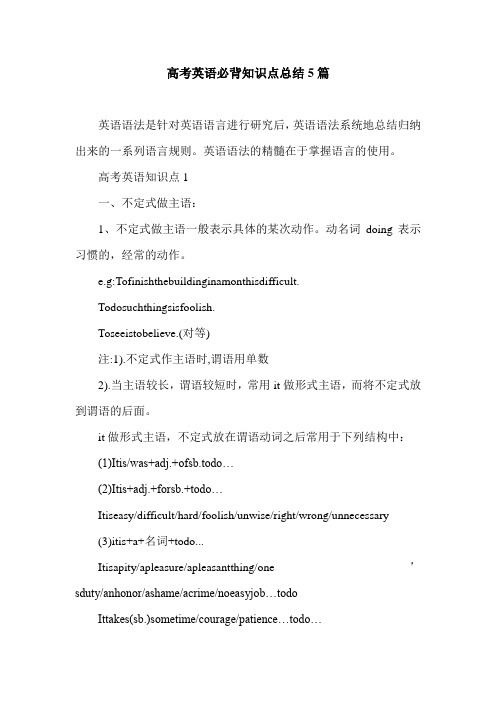
高考英语必背知识点总结5篇英语语法是针对英语语言进行研究后,英语语法系统地总结归纳出来的一系列语言规则。
英语语法的精髓在于掌握语言的使用。
高考英语知识点1一、不定式做主语:1、不定式做主语一般表示具体的某次动作。
动名词doing表示习惯的,经常的动作。
e.g:Tofinishthebuildinginamonthisdifficult.Todosuchthingsisfoolish.Toseeistobelieve.(对等)注:1).不定式作主语时,谓语用单数2).当主语较长,谓语较短时,常用it做形式主语,而将不定式放到谓语的后面。
it做形式主语,不定式放在谓语动词之后常用于下列结构中:(1)Itis/was+adj.+ofsb.todo…(2)Itis+adj.+forsb.+todo…Itiseasy/difficult/hard/foolish/unwise/right/wrong/unnecessary(3)itis+a+名词+todo...Itisapity/apleasure/apleasantthing/one’sduty/anhonor/ashame/acrime/noeasyjob…todoIttakes(sb.)sometime/courage/patience…todo…Itrequirescourage/patience/hardwork…todo…注意:probable和possible均可作表语,但possible可以用不定式作真实主语,而probable不能用不定式作真实主语。
Itisprobableforhimtocometothemeeting.(错)Itispossibleforhimtocometothemeeting.Itispossible/probablethathewillcometothemeeting.高考英语知识点2Happy Christmas?英语可说happy Christmas 吗?请看这样一道题:—__________ Christmas!—Same __________ you.A. Merry, asB. Merry, onC. Happy, asD. Happy, to此题应选D。
高一英语语法重点总结分享五篇
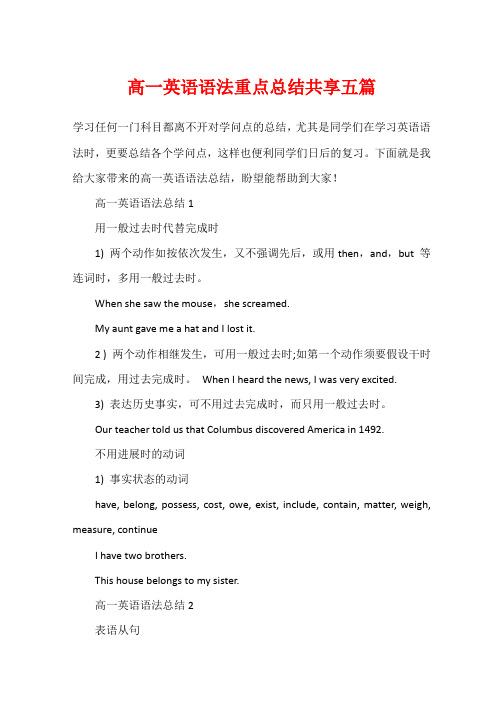
高一英语语法重点总结共享五篇学习任何一门科目都离不开对学问点的总结,尤其是同学们在学习英语语法时,更要总结各个学问点,这样也便利同学们日后的复习。
下面就是我给大家带来的高一英语语法总结,盼望能帮助到大家!高一英语语法总结1用一般过去时代替完成时1) 两个动作如按依次发生,又不强调先后,或用then,and,but 等连词时,多用一般过去时。
When she saw the mouse,she screamed.My aunt gave me a hat and I lost it.2 ) 两个动作相继发生,可用一般过去时;如第一个动作须要假设干时间完成,用过去完成时。
When I heard the news, I was very excited.3) 表达历史事实,可不用过去完成时,而只用一般过去时。
Our teacher told us that Columbus discovered America in 1492.不用进展时的动词1) 事实状态的动词have, belong, possess, cost, owe, exist, include, contain, matter, weigh, measure, continueI have two brothers.This house belongs to my sister.高一英语语法总结2表语从句表语从句在复合句中作表语的名词性从句,放在系动词之后,一般构造是“主语+连系动词+表语从句”。
可以接表语从句的连系动词有be,look,remain,seem等。
引导表语从句的that常可省略。
另外,常用的还有thereasonisthat…和Itisbecause等构造。
例如:1)Thequestioniswhetherwecanmakegoodpreparationinsuchashorttime.2)Thisiswhywecan’tgetthesupportofthepeople.3)Butthefactremainsthatwearebehindtheotherclasses.4)Thereasonheislateforschoolisthathemissedtheearlybus.高一英语语法总结3此时此刻进展时1. 表示此时此刻(说话瞬间) 正在进展或发生的动作。
最新高一英语必背语法知识点总结5篇

2023高一英语必背语法知识点总结5篇本人是AI语言模型,无法在过去写作。
在此提供2023高一英语必背语法知识点总结5篇内容供参考:一、动词时态:1. 一般现在时:表示现在普遍性的事实或存在状态,例如:I always eat breakfast at 7 o'clock. (我总是在7点钟吃早饭。
)2. 一般过去时:表示过去的事情或状态,例如:I went to school yesterday. (昨天我去了学校。
)3. 现在进行时:表示现在正在发生的动作或状态,例如:I am watching TV now. (我正在看电视。
)二、语态:1. 主动语态:表示主体执行动作,例如:The cat ate the bird. (猫吃了鸟。
)2. 被动语态:表示主体受到动作的影响或被动,例如:Thebird was eaten by the cat. (鸟被猫吃了。
)三、形容词和副词:1. 形容词:用于描述名词或代词的特征、性质、状态等,例如:He is a nice person. (他是一个好人。
)2. 副词:用于修饰动词、形容词、其他副词及整个句子的意思和语气等,例如:She sings beautifully. (她唱得美妙。
)四、介词:介词用来表示名词、代词与其他单词之间的关系,包括时间、地点、方向、原因、方式等,例如:He went to the park with his friends. (他和他的朋友去了公园。
)五、从句:从句又称为依存句,它不能独立成句,在句子中做某个成分的修饰语、主语、宾语、表语等,例如:I think that he is a good man. (我认为他是个好人。
)下面是对上述五个语法知识点的进一步解释和举例说明:一、动词时态:1. 一般现在时:表示现在的状态和习惯性的动作。
例如:She eats breakfast at 7 o'clock every day. (她每天早上7点钟吃早饭。
高三高考英语语法复习知识点总结五篇
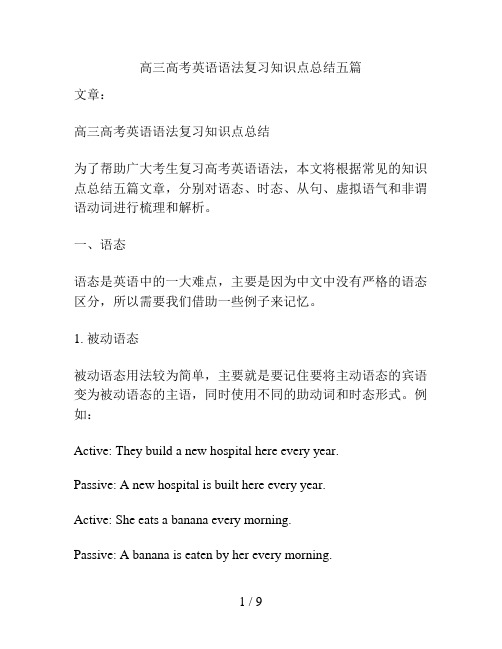
高三高考英语语法复习知识点总结五篇文章:高三高考英语语法复习知识点总结为了帮助广大考生复习高考英语语法,本文将根据常见的知识点总结五篇文章,分别对语态、时态、从句、虚拟语气和非谓语动词进行梳理和解析。
一、语态语态是英语中的一大难点,主要是因为中文中没有严格的语态区分,所以需要我们借助一些例子来记忆。
1. 被动语态被动语态用法较为简单,主要就是要记住要将主动语态的宾语变为被动语态的主语,同时使用不同的助动词和时态形式。
例如:Active: They build a new hospital here every year.Passive: A new hospital is built here every year.Active: She eats a banana every morning.Passive: A banana is eaten by her every morning.2. 主动语态主动语态用法就是正常的语态,也是比较简单的。
一般来说,我们常常使用主动语态,尤其是在描述我们自己或别人正在进行的动作。
Active: He writes a letter to his friend.Passive: A letter is written to his friend by him.Active: She plays the piano every afternoon.Passive: The piano is played every afternoon by her.3. 非定语动词非定语动词指的是在句子中作为谓语动词的动词,也就是我们最常见的动词形式。
在语态中,非定语动词主要是用来表示一些情感、感叹或存在状态等。
Active: She loves him deeply.Passive: He is loved deeply by her.Active: They usually send the report to the boss.Passive: The report is usually sent to the boss by them.二、时态时态也是英语语法中的一大难点,考生需要掌握现在时、过去时、将来时和完成时等几个常见时态。
英语语法归纳总结【五篇】

【导语】英语是全球使⽤范围最⼴的⼀门语⾔,也是国际上通⽤的语⾔,在当今英语是⼀门不错的⼀门学科,如果你想学好英语,会读英语会写英语那是远远不够的,就像你会读中⽂写中⽂⼀样,不会⽤它来组成⼀句完整的话,英语的⾳标就像中⽂的拼⾳⼀样,那⾃然英语的语法就像中⽂的语法⼀样,我们都是中国⼈都会说中⽂,那⾃然中⽂的语法就不⽤说了,那今天我们就谈谈英语的语法吧!下⾯是©⽆忧考⽹整理的内容,希望对你们有帮助!1.英语语法归纳总结 ⼀、关系代词引导的定语从句 1、that 指⼈或物在从句中作主语,宾语或表语 which 指物在从句中作主语,宾语或表语(作宾语时可以省略) who 指⼈在从句中作主语,宾语或表语 whom 指⼈在从句中作宾语 whose 指⼈或物在从句中作定语 as 指⼈或物在从句中作主语,宾语或表语 but 指⼈或物在从句中作主语,宾语或表语 注意:指物时,whose+名词=the+名词+of which或 of which+the+名词 2、as 的⽤法 (1)常⽤于下列结构:such…as; so…as;the same…as; as…as 注意:the same…as 表⽰同⼀类,不同⼀个 the same…that 表⽰同⼀个 (2)as与which的区别 a、位置不同 as可放在主句后,主句前或主句中间;which只能放在主句后。
b、as起连接作⽤,表达说话⼈的观点、看法,并指出主句内容的根据或出处,意为“正如,正像”。
Which相当于并列句,可以⽤and this来代替,意为“这⼀点,这件事’”。
注意:as常⽤于下列结构:as we know/ as is known to all, as we all can see, as has been said before/above, as might be excepted, as is often the case, ⼀般不能⽤which代替as。
高一英语语法知识点精选五篇

高一英语语法知识点精选五篇高一英语语法时态是高一期末考试中的重要知识点,也是高一英语期末考试中的重难点之一,下面就是给大家带来的高一英语语法总结,希望能帮助到大家!高一英语语法总结1不定式作主语不定式作主语,往往用it作形式主语,真正的主语不定式放至句子的后面。
例如:Its so nice to hear your voice. 听到你的声音真高兴。
Its necessary for you to lock the car when you do not use it. 不用车的时候,锁车是有必要的。
Its very kind of you to help us.他帮助我们,他真好。
It seemed selfish of him not to give them anything.他不给他们任何东西,这显得太自私了。
但是,用不定式作主语的句子中还有一个不定式作表语时,不能用It is… to…的句型。
另外,这样的句子,不能用动名词作表语。
Its for sb.和Its of sb.这样的句子中,由于表语形容词性质的不同,导致了不定式逻辑主语标志用for或of的区别。
1)for sb. 句型中的形容词一般为表示事物的特征特点,表示客观形式的形容词,如easy, hard, difficult, interesting, impossible 等:例如:Its very hard for him to study two languages. 对他来说学两门外语是很难的。
2)of sb句型中的形容词一般为表示性格,品德,心智能力,表示主观感情或态度的形容词,如good, kind, nice, clever, foolish, right。
例如:Its very nice of you to help me. 你来帮助我,你真是太好了。
用for还是用of 的另一种辨别方法:用介词for或of后面的逻辑主语作句子的主语,用介词前边的形容词作表语,造个句子。
最新高一英语必考语法知识点大全5篇
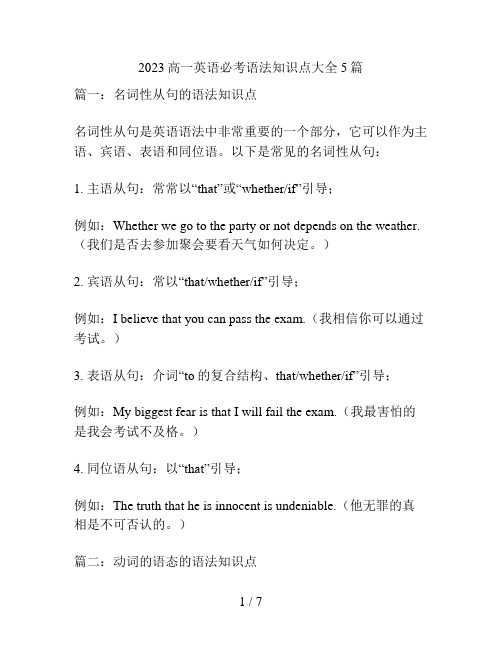
2023高一英语必考语法知识点大全5篇篇一:名词性从句的语法知识点名词性从句是英语语法中非常重要的一个部分,它可以作为主语、宾语、表语和同位语。
以下是常见的名词性从句:1. 主语从句:常常以“that”或“whether/if”引导;例如:Whether we go to the party or not depends on the weather.(我们是否去参加聚会要看天气如何决定。
)2. 宾语从句:常以“that/whether/if”引导;例如:I believe that you can pass the exam.(我相信你可以通过考试。
)3. 表语从句:介词“to的复合结构、that/whether/if”引导;例如:My biggest fear is that I will fail the exam.(我最害怕的是我会考试不及格。
)4. 同位语从句:以“that”引导;例如:The truth that he is innocent is undeniable.(他无罪的真相是不可否认的。
)篇二:动词的语态的语法知识点动词的语态是指动作或状态的表述方式,根据语态的不同,一个句子常常会有动词的主动语态和被动语态两种。
1. 主动语态:表示主语执行的动作;例如:She wrote a letter to her friend.(她写了一封信给她的朋友。
)2. 被动语态:表示主语接受的动作;例如:The letter was written by her.(信是她写的。
)在被动句中,动词被变为“be + 过去分词”,谓语动词的主语相当于动作的承受者。
3. 特殊的被动语态:由于有些动词本身并不具有主动意义,所以只能用被动语态表达。
例如:The book sells well.(这本书卖得很好。
)→ The bookis selling well.(这本书正在热销。
)篇三:形容词与副词的区别的语法知识点形容词一般修饰名词,可以表示名词的特点和性质,说明人或事物的状态和特征,而副词则是修饰动词、形容词和其他副词,可以说明动作的方式、程度和时间等。
- 1、下载文档前请自行甄别文档内容的完整性,平台不提供额外的编辑、内容补充、找答案等附加服务。
- 2、"仅部分预览"的文档,不可在线预览部分如存在完整性等问题,可反馈申请退款(可完整预览的文档不适用该条件!)。
- 3、如文档侵犯您的权益,请联系客服反馈,我们会尽快为您处理(人工客服工作时间:9:00-18:30)。
高一英语语法知识点归纳五篇
英语的时态语法学习很重要哦,时态语法的正确运用能加分不少。
下面就是给大家带来的高一英语语法总结,希望能帮助到大家!
高一英语语法总结1
各种时态的被动语态
被动语态概述
被动语态的概念:它是动词的一种形式,表示主语与谓语之间的执行或被执行关系。
主动语态表示主语是谓语动作的执行者,例如:They saw the little boy crying by the river. 被动语态表示主语是谓语动作的承受者,例如:The little boy was seen crying by the river.
被动语态的构成
被动语态的形式是由“助动词be+动词的过去分词”构成。
助动词be随着主语的人称、数、时态等的不同而变化。
几种常见时态的被动语态形式如下:
1. 一般现在时am/is/are + 过去分词
例如:Rice is planted in the south of China.
2. 一般过去时was/were + 过去分词
例如:These trees were planted the year before last.
3. 一般将来时will/shall + be + 过去分词
例如:A sports meeting will be held next week in our school.
4. 现在进行时am/is/are + being + 过去分词
例如:Your radio is being repaired now.
5. 过去进行时was/were + being + 过去分词
When he got there, the problem was being discussed.
6. 现在完成时have/has + been + 过去分词
His work has been finished.
Has his work been finished? Yes, it has. / No, it hasn’t.
7. 过去完成时had + been + 过去分词
注意:
1.除了be之外的其它系动词如get, stay等也可以和过去分词构成被动语态。
例如:Their questions haven’t got answered.
2. 含有情态动词的谓语变成被动语态使用“情态动词+ be + 过去分词”结构。
例如:
More attention should be paid to the old in this country.
This work can’t be done until Mr. Black comes.
3. 含有“be going to”, “be to”等结构的谓语,其被动语态分别用“be going to + be + 过去分词”和“be to + be + 过去分词”。
例如:
The problem is going to be discussed at the next meeting.
All these books are to be taken to the library.
4. 被动语态与系表结构的区别:“连系动词+用作表语的过去分词”构成的系表结构,与被动语态的形式完全一样,所以应注意它们的区别。
被动语态中的过去分词是动词,多强调动作;系表结构中的过去分词相当于形容词,多强调状态。
前者通常可用by 引出动作的执行者,而后者则不可以。
例如:
The map was changed by someone.(被动结构)
That custom remained unchanged for many centuries.(系表结构)
系表结构中的过去分词通常可被very修饰,被动语态中的过去分词往往要用much修饰。
例如:
He was very excited.(系表结构)
He was much excited by her words.(被动结构)
5. 主动形式表被动意义。
有些动词的主动形式有被动意味,如open, read, sell, shut, wash, wear, write等。
此时句子的主语一般是物。
例如:
These books sell well. 这些书很畅销。
The door won’t shut. 这门关不上。
The clothes wash well. 这些衣服很好洗。
高一英语语法总结2
一般现在时
1. 表示现在习惯或经常反复发生的动作或存在的状态, 常
与usually, always, sometimes, often, every day / week / month / year等时间状语连用。
[例句] He often does his homework in his study.
2. 表示主语现在的特征、性格和状态。
[例句] The dictionary belongs to me.
3. 表示客观规律或科学真理、格言, 以及其他不受时间限制的客观存在。
[例句] The moon goes around the sun.
4. 在有连词if, unless, before, as soon as, when, once, however等引导的时间、条件和让步状语从句中, 用一般现在时表将来。
[例句] If you work hard, you won’t fail in the exam.
高一英语语法总结3
一般过去时
1. 表示过去某一时间发生的动作或存在的状态。
[例句] She went to the zoo yesterday.
2. 在时间、条件状语从句中代替过去将来时。
[例句] He said when she came he would tell her.
高一英语语法总结4
.同位语从句
同位语从句就是在复合句中作名词的同位语的名词性从句。
1.同位语从句的功能
同位语从句对于名词进一步解释,说明名词的具体内容,一般由that引导,例如:
1)Theking’sdecisionthattheprisonerwouldbesetfreesurprisedallthep eople.
2)Theorderthatallthesoldiersshouldstaystillisgivenbythegeneral.
高一英语语法总结5
虚拟语气1) 概念
虚拟语气用来表示说话人的主观愿望或假想,所说的是一个条件,不一定是事实,或与事实相反。
2) 在条件句中的应用
条件句可分为两类,一类为真实条件句,一类为非真实条件句。
非真实条件句表示的是假设的或实际可能性不大的情况,故采用虚拟语气。
真实条件句
真实条件句用于陈述语气,假设的情况可能发生,其中if 是如果的意思。
时态关系
句型:条件从句主句
一般现在时shall/will + 动词原形
If he comes, he will bring his violin.
高一英语语法知识点归纳五篇相关*:
1.
2.高一英语语法梳理五篇分享
3.2020高一英语必背语法知识点总结5篇
4.高一英语知识点总结语法5篇梳理
5.高一英语语法整理精选五篇汇总
6.高一英语语法整理精选五篇分享
7.高一英语知识点总结语法5篇分享
8.2020高一英语必考语法知识点大全5篇
9.最新2020高一英语必考语法知识点大全5篇
10.人教版高一英语知识点精选5篇归纳分享。
